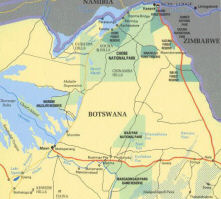|
Makgadikgadi Salt Pans
The complex of salt
pans found in Botswana’s eastern regions are a striking
physical feature, and some of the largest of their kind in
the world. The pans are huge, flat expanses of hot,
sun-blasted terrain, fringed by vegetated islands and
peninsulas, once part of a great superlake which covered
much of northern Botswana. This desolate landscape offers
nothing but sand and sky, and yet it’s eerily silent fossil
beaches, stunted red baobab trees and mysterious stone
walls, leave an impression on every visitor.
Nxai Pan
Although N'[xai Pan was also once part of the great superlake,
it is quite different in character to the Makgadikgadi Salt
Pans, as it boasts broad hectares of short sweet grasslands
with occasional “islands” of trees. The rich grassland
provides good grazing and attracts springbok, impala,
gemsbok, giraffe, kudu, hartebeest, zebra, wildebeest, all
followed by leopard, lion and hyena, as well as a wide array
of birdlife. Baines baobabs, a cluster of seven trees which
have been immortalized by many painters and photographers
over the years, are located within the park, and make an
excellent picnic stop.
Nxai Pan is home to the now famous pride of lions filmed by
Tim Liversage in conjunction with National Geographic in
“ROAR – Lions Of The Kalahari”. |

